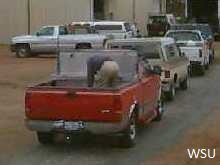 Take precautions when transporting pesticides. Accidents can happen even during a short trip. Pesticides containing solvents or their containers can be flammable or explosive. Smoke, fumes, vapors, dusts, and liquids can be toxic. The driver, others in the vehicle, and people outside the vehicle may be exposed to pesticides if there is an accident. An accidental spill can damage vegetation, injure domestic animals and wildlife, and impair water quality.
Take precautions when transporting pesticides. Accidents can happen even during a short trip. Pesticides containing solvents or their containers can be flammable or explosive. Smoke, fumes, vapors, dusts, and liquids can be toxic. The driver, others in the vehicle, and people outside the vehicle may be exposed to pesticides if there is an accident. An accidental spill can damage vegetation, injure domestic animals and wildlife, and impair water quality.
Improperly loaded pesticide containers can fall from your vehicle, or become punctured or torn during transit. Because pesticides often are transported on public roads, the potential damage from accidents is great, both to human health and to the environment. Listed below you’ll find additional information about transporting pesticides that may be helpful; some of the information may be specific to each state. The information on transporting pesticides given in the following sections of this module is general to the US. Your state may have additional or more stringent requirements.
Resources
Penn State Extension Safety Pesticide Fact Sheet, Transporting Pesticides in Pennsylvania, Part 1: Safety Recommendations and Legal Requirements
Penn State Extension Safety Pesticide Fact Sheet, Transporting Pesticides in Pennsylvania, Part 2: Safety Recommendations and Legal Requirements
Purdue University Cooperative Extension Service, Pesticides and Commercial Vehicle Maintenance
Purdue University Cooperative Extension Service, Pesticides and Fleet Vehicles – Transporting Pesticides Safely
University of Florida Extension, Pl-160. Transporting Pesticides and Understanding the Rules of the Road: Farmers, Ranchers and Production Agricultural Operations
University of Nebraska – Lincoln Extension Circular 2507. Safe Transport, Storage, and Disposal of Pesticides
Compiled by Jan Hygnstrom, Erin Bauer and Clyde Ogg, University of Nebraska – Lincoln
